Text

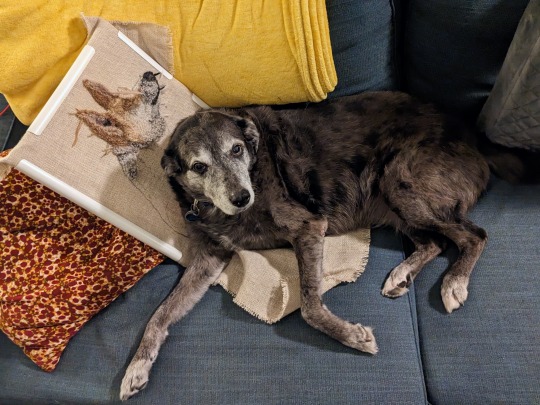
Dog on dog rug (in progress)
13 notes
·
View notes
Text
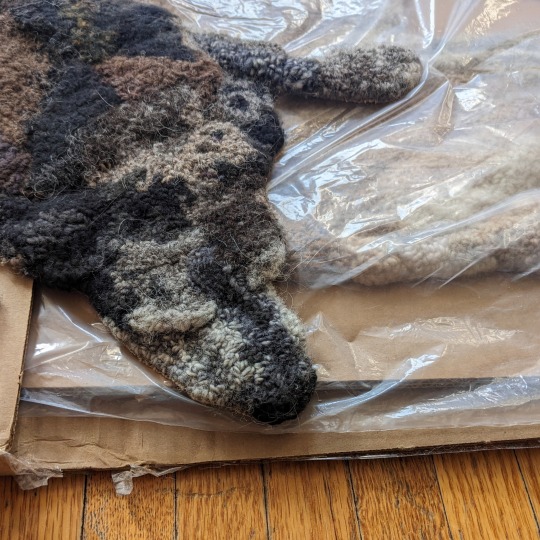
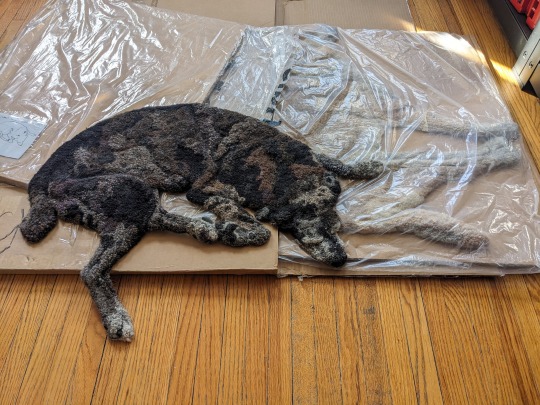
Close-up of the face of a hand hooked dog rug. Two were just shipped back to me; it's nice to send them out into the world, and nice to get them back.
27 notes
·
View notes
Text
Thanks @butch4maryoliver for posting the dog rugs! The bottom two photographs are by Bucky Miller for his Wraymour&Flanigan project
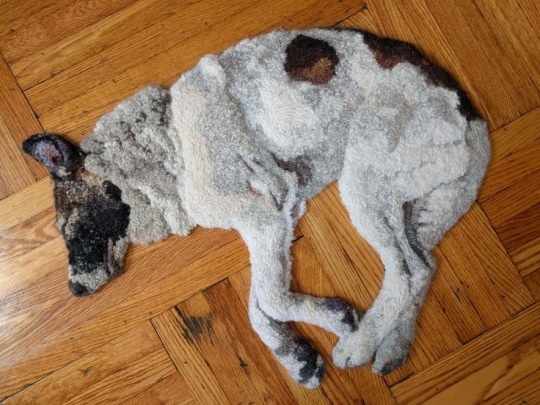


Three of Emily O’Leary’s hand-hooked dog rugs, made between 2019-2023
5K notes
·
View notes
Text

Pre-op rug hooking in the hospital. C-spine disc replacement went fine; I'll have to give the hooking at least a brief rest though
10 notes
·
View notes
Text


I rug hooked an owl to fit in the front opening of this wicker bag. A very small owl. The eyes are glass. I wish the owl was a little bit more legible, I could have used fewer colors and more contrast, I think.
8 notes
·
View notes
Text

Cobalt the dog and her rug. I usually hook dog rugs from photos of dogs I don't know, but this was for a specific show, so I made the rug of my own dog, Cobalt, a then 10 yr old mutt. Hand-hooked wool yarn on linen.
24 notes
·
View notes
Text

A life-sized dog rug, stretching and sleeping. Hand-hooked with mostly wool yarn on a linen backing. Finished Nov 2023.
I think this guy would work out to be about a 30-35 lb dog in real life. Instead he weighs just a few pounds.
68 notes
·
View notes
Text
Hooking rugs that look like dogs
Here's how I do it:
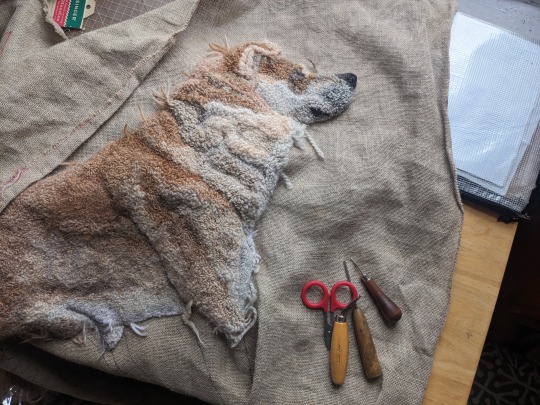
The process I use is called rug hooking (not latch hook or punch needle or tufting, though it is the forerunner of the latter two techniques). Rugs are hooked by pulling loops of fabric strips or yarn through the holes of a base fabric with a coarse open weave, like burlap, or linen, or rug warp. The loops are pulled through the fabric with a squat-handled hook whose business end is shaped like a crochet hook. There are no knots and the loops aren't sewed down in any way. The whole thing stays put just by the tension of all those loops packed together in the weave of the foundation fabric.
This isn't a true detailed tutorial but a walk-through of my particular process. The same information is on my web page, emilyoleary.com .
I hook with yarn, rather than with cut strips of wool fabric, which is what many rug hookers use. I can get a looser, more organic distribution of loops with yarn than I could with wool strips, which are hooked in neat lines.
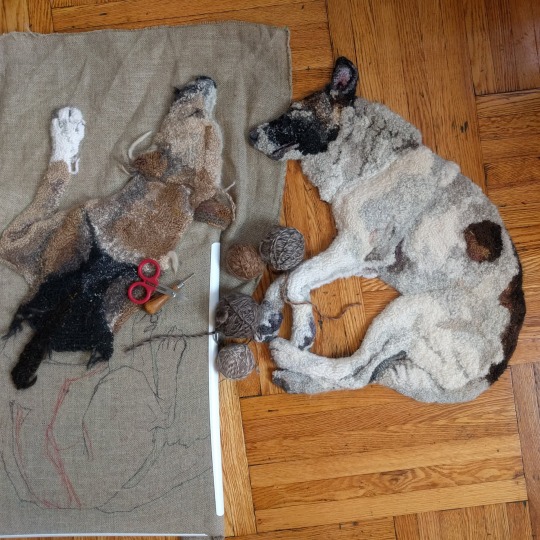
Mostly I use wool yarn. In terms of yarn weight, I can use DK, worsted, or Aran. If I'm using thicker yarn, I leave more holes un-hooked; if I'm using finer yarn, I hook more densely or double up lengths of it. I particularly like using single ply yarns (like Brown Sheep Lamb's Pride or Malabrigo Worsted). I don't keep count, but I think I usually use around two dozen types and colors of yarn per dog.
This is my yarn wall in my apartment. Mostly brown and gray yarn!

I start from a small drawing in my sketchbook, then I head to FedEx office to use a copy machine, blowing up the drawing repeatedly and experimenting with how big the dog rug should be.

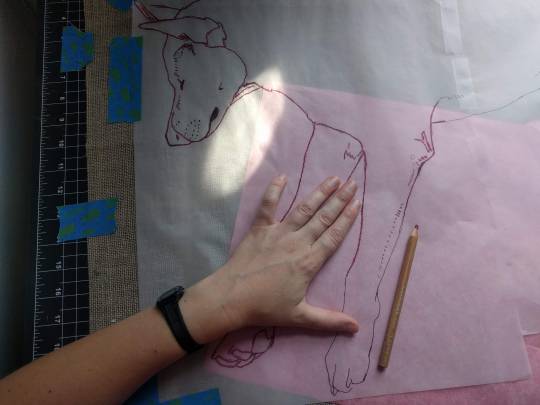
After transferring the image onto my linen, I immediately go over it with Sharpie, because the Saral is really difficult to see and really easy to rub off.

The rug is held taut by a PVC quilting frame that I set on my lap.
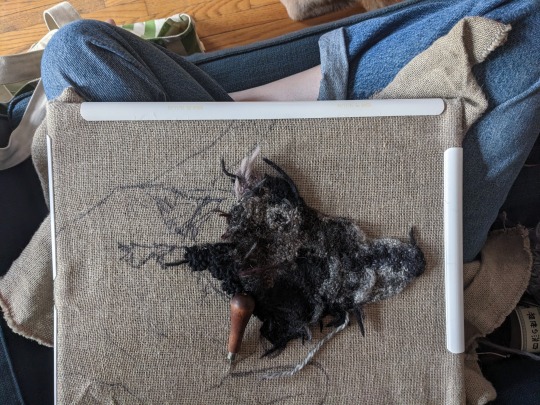
I push my hook down through the fabric with my right hand and my left hand stays below the fabric and guides the yarn while I pull it up and through with the hook. Not every hole in the fabric is hooked. Hooking every hole would make the rug too dense. I do hook pretty densely, though-- If you pick up one of my rugs you’ll see they have a slight curl to them, which is because they’re hooked pretty tight. I'm using all different weights and types of yarn, so it's a challenge to keep the overall tension even.
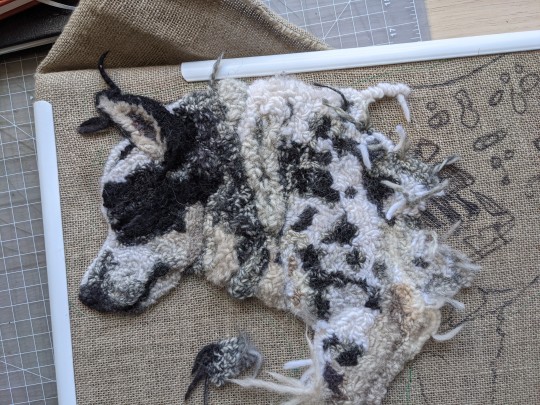
I hook my loops at varying heights to create a very low relief. Sometimes I trim the loops to make them fluffier or wispier or to shape a particular part. I look at a reference photo while I work and pull out and redo sections a lot.
My q-snap frame can accommodate the growing dog rug. I have extenders to make it bigger and I can clamp around my hooking.

The back of a rug looks like lines of little stitches. The lines are little worm trails snaking around because lines of hooking are not supposed to cross over each other. It's important to start a new length of yarn rather than cross over a stitch you already made! I read this when I first started and took it to heart. It makes it much easier to undo and redo hooking if you have to (and I redo sections A Lot). It also keeps the back from getting too bulky and resulting in uneven wear on the back of a functional rug that gets floor use.

When I’m done hooking everything I turn the rug over and brush watered-down Sobo glue on the edges of the dog, making sure to get one or two of the outermost lines of hooking. I do a couple coats of this thinned out glue. I'm careful not to use so much that it seeps to the front of the rug. When the glue is dry I cut the rug out, but I don't cut so close that the loops don't have any linen to keep them in.

It generally takes me at least several months to finish one dog rug. My hooking frame and yarn bag are very portable (though bulky) so I can hook out and about at coffee shops or the library or a brewery if there's enough space and light.
Hooking in the wild makes me an ambassador for making things in general and rug hooking in particular. I answer people's questions and always emphasize how relatively easy it is to get started hooking. Sometimes I get anxious that other people will hook rugs that look like mine but better, but I think that working in a traditional medium means you should share your knowledge for the good of the craft.

33 notes
·
View notes
Text
Dog Rug

Life size dog rug finished 2021
Hand-hooked with mostly wool yarn on a linen backing
emilyoleary.com
32 notes
·
View notes
Text
Sleeping dog X-mas card

2019 holiday card with sleeping dog on braided rug
For a restful xmas
Three color linoleum block print on rice paper
9 notes
·
View notes
Text
Botanical Linocut X-mas Card

My 2020 card with a witchy hand holding a sprig of fir tree and a little glowing candle
Kind of a spooky mystical christmas card
Linoleum block print on rice paper
7 notes
·
View notes
Text
Big Papier-mâché Caterpillars and Bugs


For my sister’s pre-pandemic baby shower a few years ago I made a bunch of Eric Carle-inspired Very Hungry Caterpillars. They were made from “bleeding” color tissue paper, watered down Elmer’s glue, and wire. There were a lot of steps to the process, but the whole thing worked out very close to how I imagined it, which if you make a lot of stuff, you know that’s kind of rare! Below is a step-by-step process for making the ‘pillars.
My mom had asked me to make centerpieces for the baby shower and I wanted to do something brightly colored and gender neutral. I thought papier-mache would be ideal because I could work up something sculptural and lightweight and not spend a lot of money. I settled on Eric Carle’s “The Very Hungry Caterpillar” because it seemed like showers are for some reason obligated to have a theme and because I could replicate Carle’s distinctive style by using transparent brightly colored tissue to get close to the stained glass appearance of Carle’s collages. Taking a page out of his own book, I guess.

Materials:
Bleeding Art Tissue
Elmer’s Glue All
armature wire
floral wire
Das Paper Clay (any self hardening clay would work, or you could bake polymer clay)
Process:
I first made “donuts” for the segments of the caterpillars’ bodies by crumpling tissue into flattened sphere shapes and then layering strips of tissue over the shapes with white glue diluted to a very thin consistency. I varied the greens I used (and also used blue and yellow for the interior crumples) in order to get richer greens. The bleeding art tissue looks great when used this way, but is Extremely messy-- my hands were very colorful.
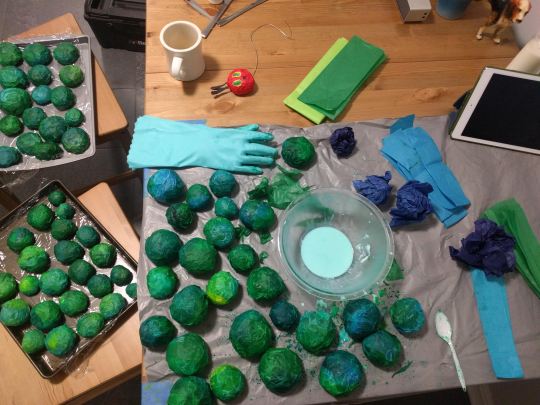
I made the red heads of the ‘pillars in the same way.
The faces of the caterpillars were just glued on-- I used more opaque paper (rather than the tissue) for those and painted paper for the colors I didn’t have.
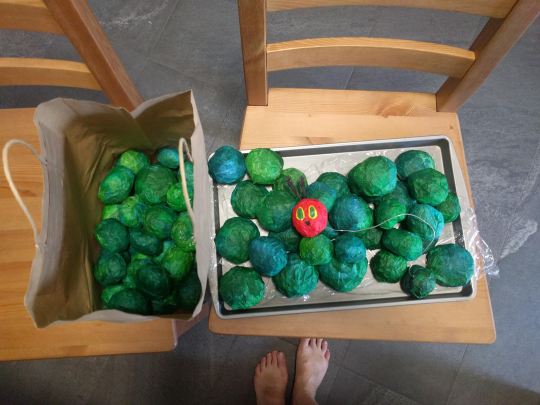
I strung the donuts together with armature wire by piercing them and using a strong needle (the heavy duty sort you get in those packs hand sewing needles for upholstery and sail repair). So that the wire didn’t show, I didn’t run the wire all the way through the head or the final segment, instead looping it in the back of those donuts, pulling the whole caterpillar somewhat tight,and twisting the wire back in on itself to hold it together. The armature wire holds nice bends, so once strung, I could form the caterpillars into lively shapes. Each caterpillar was a slightly different shape, which made sense, since the caterpillar changes shape in the course of the book!
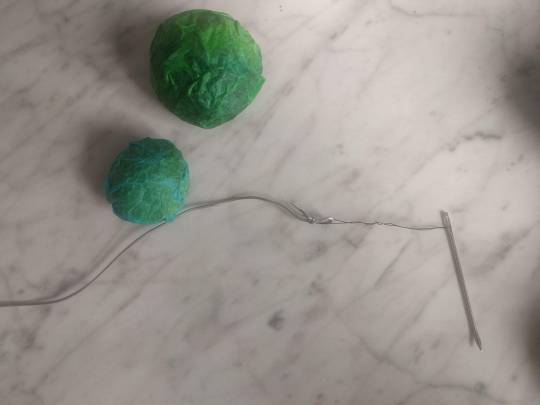
For the legs/feet I formed little “hershey’s kiss” shapes out of clay around short lengths of floral wire. When they were dry I glued brown tissue on them and stuck them into the green body segments with a little dab of glue where they met the body.
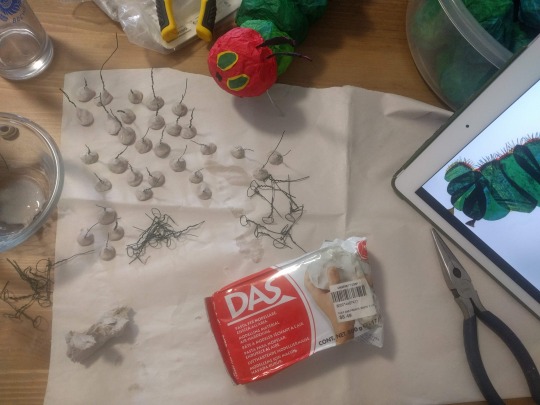
The antennas were made by covering skinny loops of floral wire with tissue and sticking them into the head in the same way I did the legs/feet (the antennas are pink in the photo because I didn’t have black tissue-- I painted them black before sticking them in the heads).
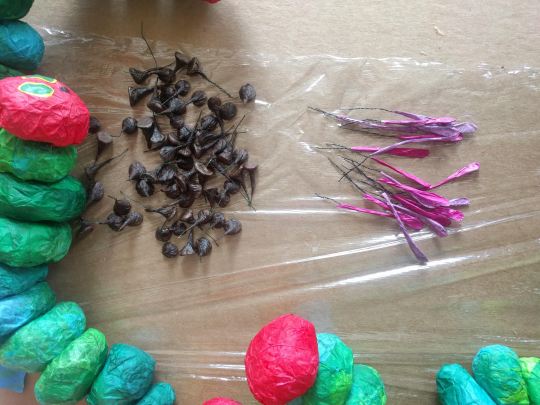

After I made all those caterpillars I made some ladybugs, butterflies, and a honeybee! The bee and butterflies were made on lengths of floral wire so they could float above flower arrangements.
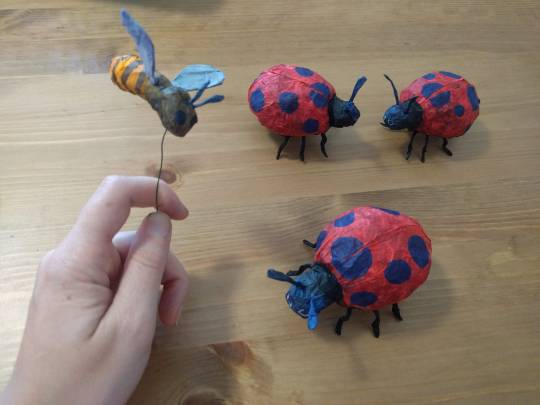

The caterpillars worked well as centerpieces along with some flowers and when the party was over people with kids took them home as decorations.
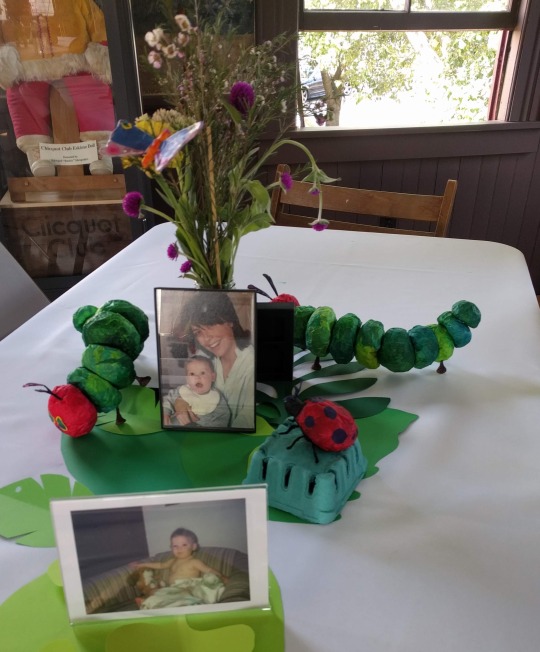
#ericcarle#eric carle#very hungry caterpillar#paper mache#papier mache#papier mâché#bugs#tutorial#crafts#kids crafts#the very hungry caterpillar
101 notes
·
View notes
Text
Quarantine Papier-mâché Vase


Like everybody else, I turned to glue and cardboard during lockdown last year. At first I was surprised that so many other people had the same idea at the same time but of course it makes sense— everybody has the materials at hand and it’s a very forgiving medium (because you basically just have to accept the lopsided, lumpy end result as inevitable and charming).
Here’s the first vase I made. The background is black tissue paper. The animals are watercolor on vellum.
0 notes
Text


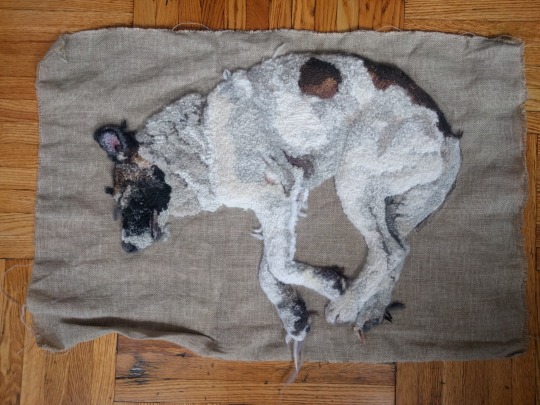

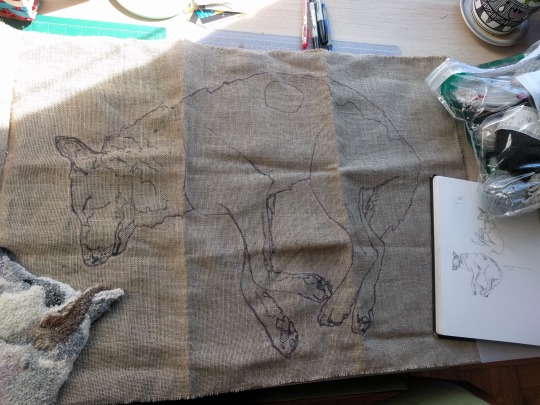
Life-sized hooked rug shaped like dog with injured elbow. The dog rugs and my other work are on my website.
36 notes
·
View notes
Text

Process photo of a hooked rug shaped like a smallish black and white dog. The blob to the left is me testing colors of yarn. When it’s finished the edges are stitched under so that it’s just the dog, no background. Some more photos on my website:
1 note
·
View note
Photo
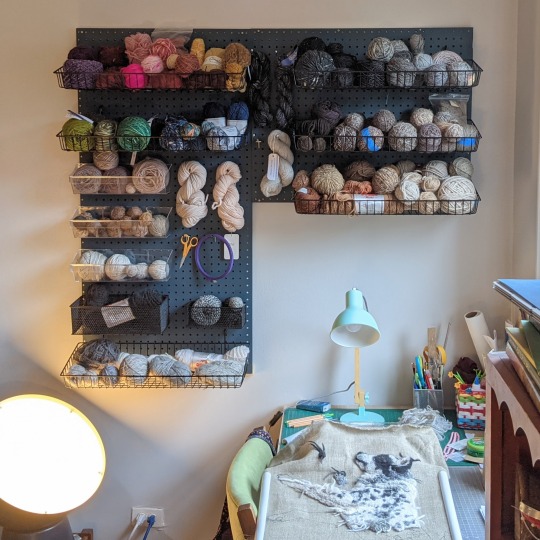

Peg board with my yarn for rug hooking. Mostly grays, blacks, browns and tans! My current project (dog-shaped rug) is on the desk.
16 notes
·
View notes
Photo
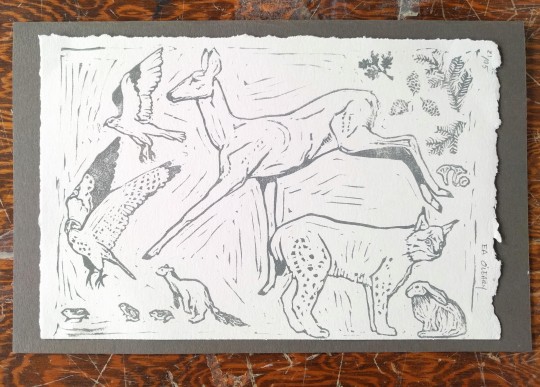
2015 holiday/x-mas card; linoleum block print. With wildlife from the taiga.
3 notes
·
View notes